Introduction
In the rapidly evolving landscape of mobile applications, ensuring quality and performance through rigorous testing has never been more critical. As the mobile app market is projected to soar to $935 billion by 2024, developers face immense pressure to deliver seamless user experiences that not only meet but exceed expectations.
Mobile app testing serves as the backbone of this endeavor, encompassing a variety of methodologies aimed at optimizing functionality, performance, and security across diverse devices and platforms. With users interacting with their apps more than ever—checking their smartphones an average of 47 times a day—understanding the nuances of mobile app testing becomes essential for fostering user satisfaction and retention.
This article delves into the vital components of mobile app testing, explores various testing types, and provides a structured approach to ensure that applications are not only functional but also primed for success in a competitive market.
Understanding Mobile App Testing: An Overview
Application evaluation serves as a crucial systematic procedure intended to demonstrate how to test mobile apps for functionality, performance, and usability. This multifaceted approach encompasses various testing methodologies that illustrate how to test mobile apps, ensuring the application not only meets expectations but also operates seamlessly across diverse devices and platforms. With Android 13's install base growing from 15% to 22.4%, the significance of optimized applications is more pronounced than ever.
According to Shreya Bose, a community contributor,
The average smartphone owner checks their device 47 times a day, underscoring the urgent need for apps that provide exceptional experiences.
For developers and marketers, grasping application assessment is crucial, as it directly impacts consumer satisfaction and retention. Essential elements of how to test mobile apps include:
- Functional analysis, which confirms that the application executes its intended tasks
- Performance assessment to gauge speed and responsiveness
- Usability evaluation to guarantee ease of use
- Security assessment to protect user data
Each of these components plays an indispensable role in identifying potential issues prior to the app's launch, thereby enhancing its overall quality and effectiveness in a market projected to reach $935 billion by 2024. Significantly, the smartphone application market generated $475.90 billion in revenue in 2022, mainly from free applications utilizing in-app purchases and advertisements, emphasizing the financial consequences of efficient app evaluation. As the demand for software engineers and quality assurance analysts continues to rise—projected to grow by 25% from 2021 to 2031—the necessity for robust mobile app evaluation methodologies becomes increasingly clear.
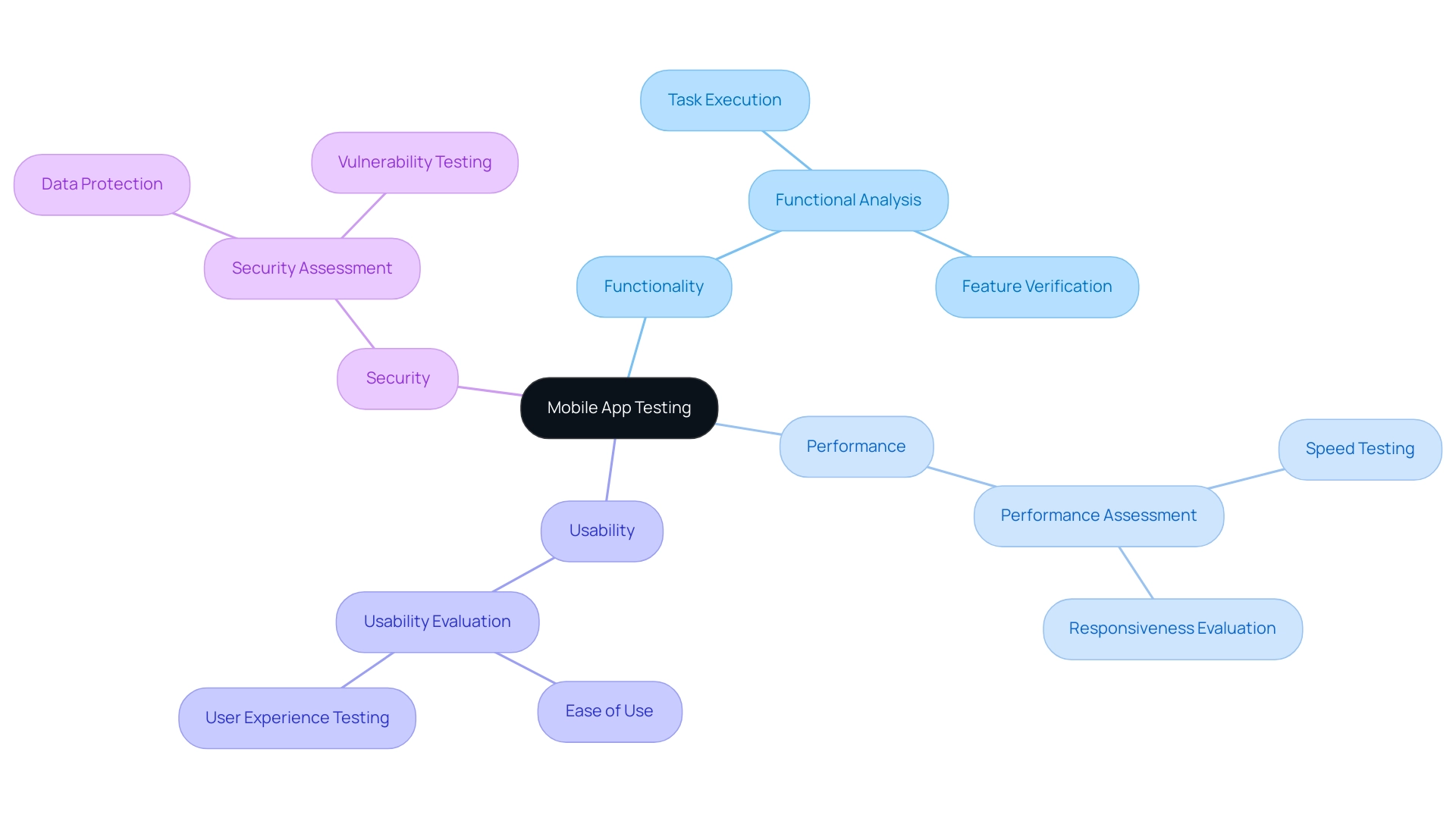
Exploring Different Types of Mobile App Testing
Understanding how to test mobile apps involves several distinct evaluation types, each critical for ensuring the application's success in a competitive market. Here’s an overview:
-
Functional Testing: This type verifies that the app operates as intended, covering all features and functionalities. It ensures that every element functions correctly, which is crucial given that 70% of app uninstallations stem from crashes. As emphasized in the case study titled "Importance of Mobile App Evaluation Strategy," a strong assessment approach can significantly reduce these risks and improve client satisfaction.
-
Performance Testing: Concentrated on the app's speed, responsiveness, and stability under different conditions, performance testing is essential for providing a smooth experience. It identifies how the app behaves under stress and varying loads, which directly affects retention.
-
Usability Testing: This assesses the experience of individuals, ensuring the app is intuitive and accessible. By examining interactions, testers can refine the interface to enhance engagement and satisfaction.
-
Security Testing: With rising concerns over data privacy, this type identifies vulnerabilities within the app, protecting individual information and ensuring compliance with regulations.
-
Compatibility Testing: As 80% of individuals depend on major browsers like Google Chrome and Mozilla Firefox, compatibility testing ensures the app performs well across different devices, operating systems, and screen sizes. This is essential as individuals interact extensively with applications for social networking and communication. With the increasing reliance on these browsers, ensuring compatibility is not just an option but a necessity for keeping customers.
As Steve Bennett, a Business Formation Expert, aptly puts it, "With LLCBuddy, you're not just getting a tutorial; you're gaining a trustworthy partner for your entrepreneurial journey." Likewise, a thorough application evaluation strategy serves as a dependable ally in managing the intricacies of app development.
By understanding these diverse evaluation types, developers can learn how to test mobile apps effectively to implement a comprehensive strategy that not only meets necessary standards but also significantly enhances user experience and retention.
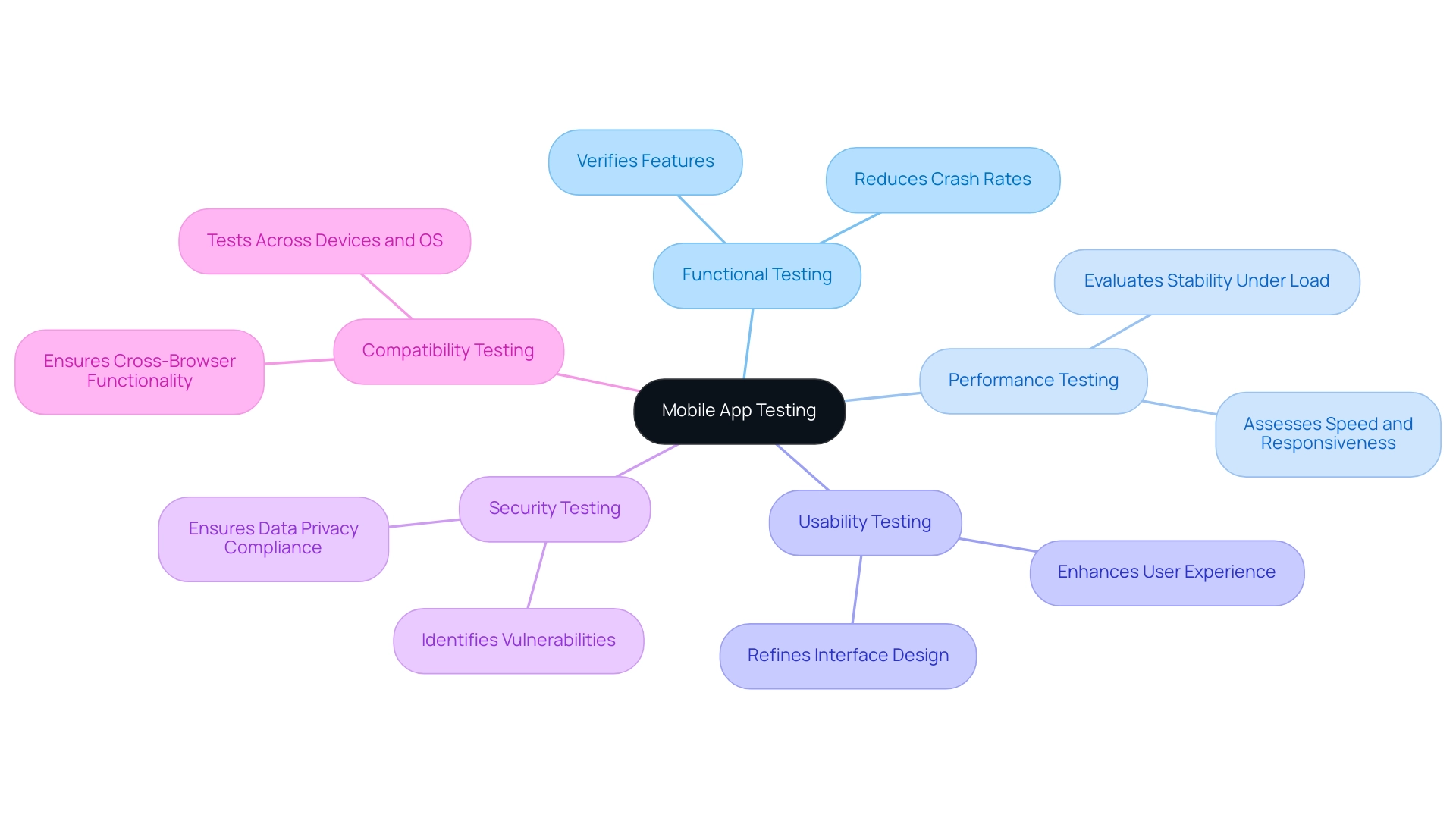
Step-by-Step Guide to Testing Mobile Apps
To conduct effective mobile app testing, follow this structured approach:
-
Define Evaluation Objectives: Begin by clearly determining the goals of your assessment. This foundational step ensures that all subsequent efforts are aligned with specific outcomes, such as enhancing experience or identifying performance bottlenecks.
-
Choose Assessment Types: Based on your defined objectives, select the appropriate kinds of evaluation. This could encompass functional evaluations to verify core features, performance assessments for responsiveness under load, or usability evaluations to gauge interaction.
-
Develop Test Cases: Craft comprehensive test cases that detail specific scenarios you intend to test. This involves outlining expected outcomes and conditions to ensure thorough coverage of potential interactions.
-
Select Devices and Platforms: Identify the range of devices and platforms for testing, including both high-end and low-end models. Given that tests can be run simultaneously across multiple devices and versions, this step allows you to cover thousands of test cases efficiently. It is crucial to ensure performance optimization for all device types to deliver a smooth experience.
-
Execute Tests: Carry out the tests as per your established cases, meticulously documenting any issues encountered. This phase is crucial for capturing real-time performance and experience data.
-
Analyze Results: After assessment, evaluate the results to identify patterns and areas for improvement. This analysis is essential for understanding how the app performs across different environments and conditions.
-
Report Findings: Compile a comprehensive report summarizing your findings. This should include recommendations for developers on how to address identified issues, enhancing the app’s overall quality.
-
Retest: Finally, after developers address the issues, retest the application to confirm that fixes are effective and that no new problems have emerged.
This step-by-step procedure is essential for understanding how to test mobile apps, which guarantees comprehensive evaluation and ultimately leads to a smoother experience for individuals. As the Senior Content Writer aptly states, "When the day's work ends, you'll find her immersed in literary escapades in her quaint book house," emphasizing the importance of dedication in the evaluation process. With approximately 80% of individuals accessing the internet via popular browsers like Google Chrome and Mozilla Firefox, ensuring compatibility across these platforms is essential.
Additionally, as demonstrated in the case study on RTL languages, evaluating interfaces for diverse user needs can significantly enhance accessibility and coherence. For instance, during the 'Select Devices and Platforms' step, ensure that your app's layout adjusts appropriately for right-to-left languages, making your application more inclusive.
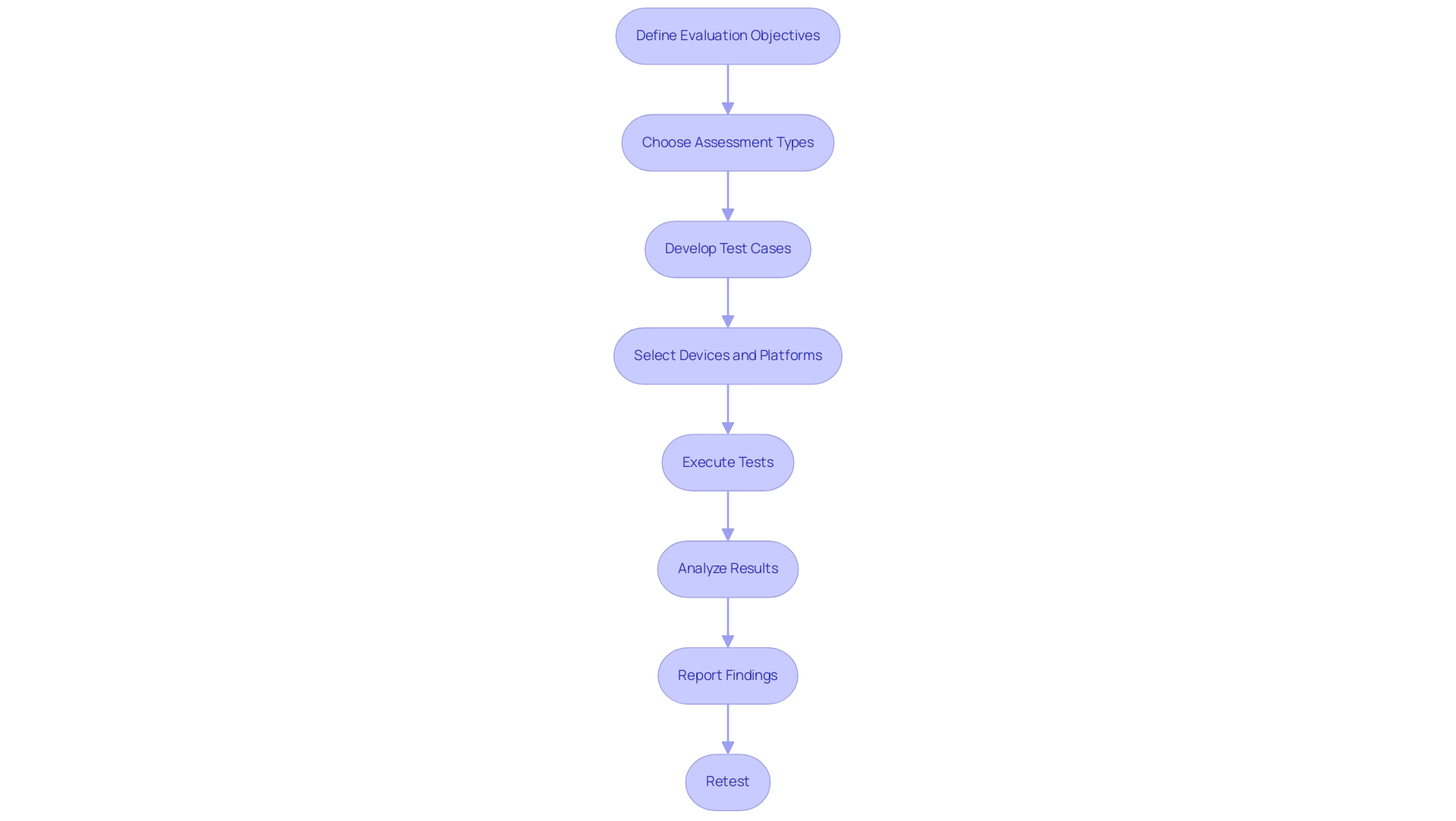
Choosing the Right Tools and Frameworks for Mobile Testing
When selecting tools and frameworks for mobile app evaluation, several critical criteria should guide your decision-making process:
- Compatibility: It is essential to ensure that the chosen tool supports a wide array of devices and platforms, enabling comprehensive evaluation across various environments.
- Automation Capabilities: Opt for tools that offer robust automation features. Automation not only saves valuable time but also significantly reduces the manual effort involved in repeated evaluation scenarios, which is essential for understanding how to test mobile apps. As emphasized by industry specialist Shreya Bose,
The average mobile user checks their smartphone 47 times a day,
highlighting the need for effective evaluations to keep up with user expectations. - User-Friendly Interface: A user-friendly interface is crucial for facilitating smooth adoption by your team. Intuitive and easy-to-navigate tools can enhance productivity and provide insights on how to test mobile apps, thereby reducing the learning curve.
- Choose tools that can seamlessly connect with your current development and evaluation environments to understand how to test mobile apps. This compatibility guarantees a smoother workflow and minimizes disruptions during the evaluation process.
- Community Support: Strong community support is invaluable when it comes to troubleshooting and sharing best practices. Tools with an active user community can provide additional resources and insights on how to test mobile apps, enhancing your evaluation strategies. Furthermore, taking into account the growth of Flutter, which allows for the creation of expressive UIs utilizing widgets and rich motion APIs, it is essential to choose tools that support this framework to improve your application evaluation. Some of the most popular tools in the market, such as Appium, Selenium, and TestComplete, each bring unique features that can improve how to test mobile apps during your evaluation process. For example, Autify, a no-code, AI-driven platform, automates software evaluation for both web and smartphone applications. With its AI-driven auto-repair functionality for test scenarios, Autify not only ensures reliability but also saves significant time during UI changes, illustrating the growing importance of automation in mobile application evaluation. It's also worth noting that in a global context, Spanish is the primary second language spoken by 31.2% of software testers, followed by French at 12.2% and German at 11.2%. This diversity can affect the selection of tools and frameworks to ensure inclusivity in evaluation practices.
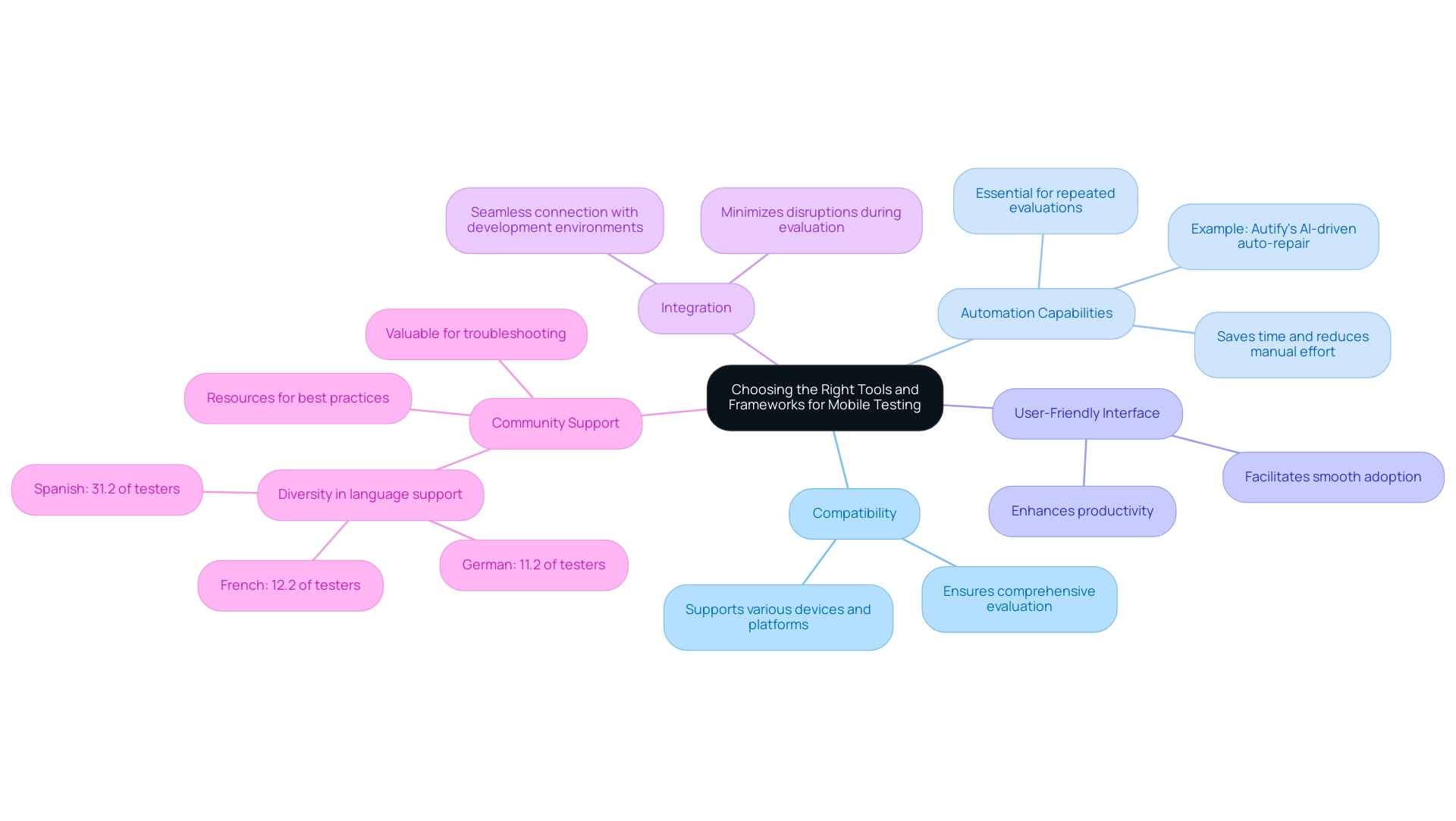
Overcoming Challenges in Mobile App Testing: Best Practices
Mobile app evaluation can present a variety of challenges, but implementing proven best practices can significantly mitigate these issues:
- Prioritize Evaluation Early: Initiating assessments during the development phase is crucial. This proactive approach allows teams to identify and address issues earlier, ultimately enhancing client satisfaction and reducing costly fixes post-launch.
- Utilize Real Devices: Testing on actual devices provides the most accurate performance results. This practice is essential, especially given that the install base for Android 13 has grown from 15% to 22.4%, and 59.8% of devices are now running actively supported Android versions. Real-world evaluation ensures your app performs well across diverse hardware, which is critical for user experience.
- Automate Where Possible: Utilizing automation tools can streamline repetitive evaluation tasks, increasing efficiency and freeing up valuable time for testers to focus on more complex scenarios. Automation not only accelerates the assessment process but also improves accuracy.
- Maintain Clear Communication: Effective collaboration between testers and developers is vital. Establishing open lines of communication ensures that issues are identified and resolved quickly, fostering a culture of shared responsibility for the app’s performance.
- Regularly Update Evaluation Strategies: The environment of app assessment is continuously evolving. Staying informed about the latest trends and technological advancements—such as the projected 25% growth in employment for software engineers and quality assurance analysts from 2021 to 2031—will enable teams to adapt their strategies effectively. This growth reflects the rising demand for skilled testers, highlighting the necessity of effective evaluation methods.
By adhering to these best practices, you enhance your understanding of how to test mobile apps, ultimately driving better user experiences and improving return on investment. Ongoing improvement of app features through experimentation and data analysis is crucial for attaining these goals. As Oleksandr Kruglyak, Head of Dev Department at TRIARE, states,
In general, focusing on customer experience in 2024 is a smart strategy for businesses that want to stand out from the crowd.
Embracing early testing and effective strategies not only addresses current challenges but also positions your app for success in a competitive market.
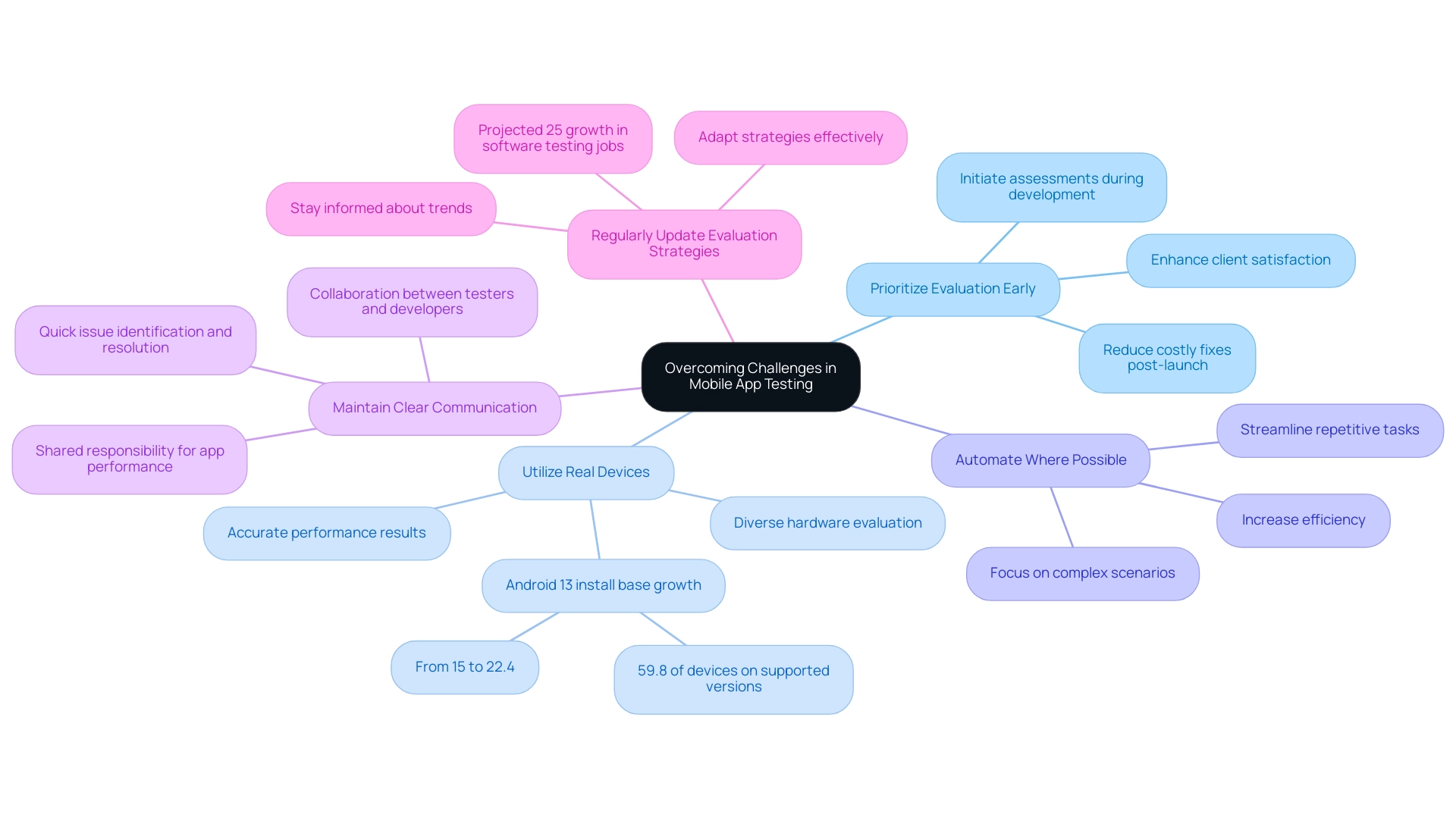
Conclusion
In the dynamic realm of mobile applications, rigorous testing emerges as a vital pillar for success. This article has outlined the essential components of mobile app testing, emphasizing the importance of methodologies such as:
- Functional testing
- Performance testing
- Usability testing
- Security testing
- Compatibility testing
Each type plays a critical role in ensuring that applications not only function as intended but also provide an exceptional user experience across various devices and platforms.
Moreover, the step-by-step guide to testing highlights the structured approach necessary for effective testing, from defining objectives to retesting after issues are resolved. The selection of appropriate tools and frameworks further enhances the efficiency of the testing process, enabling developers to keep pace with the ever-increasing user expectations.
Addressing the challenges inherent in mobile app testing through best practices such as:
- Early testing
- Real-device usage
- Automation
can significantly improve outcomes. As the mobile app market continues to expand, prioritizing quality through comprehensive testing strategies will be paramount for developers seeking to thrive in this competitive landscape. Ultimately, the commitment to rigorous mobile app testing not only enhances user satisfaction and retention but also positions applications for long-term success in a rapidly evolving market.





